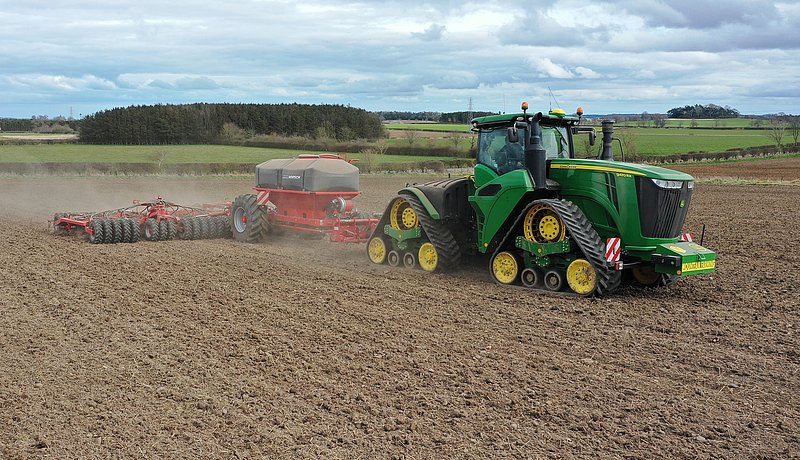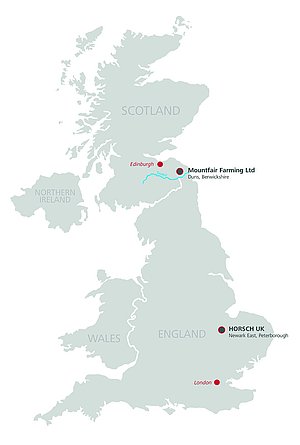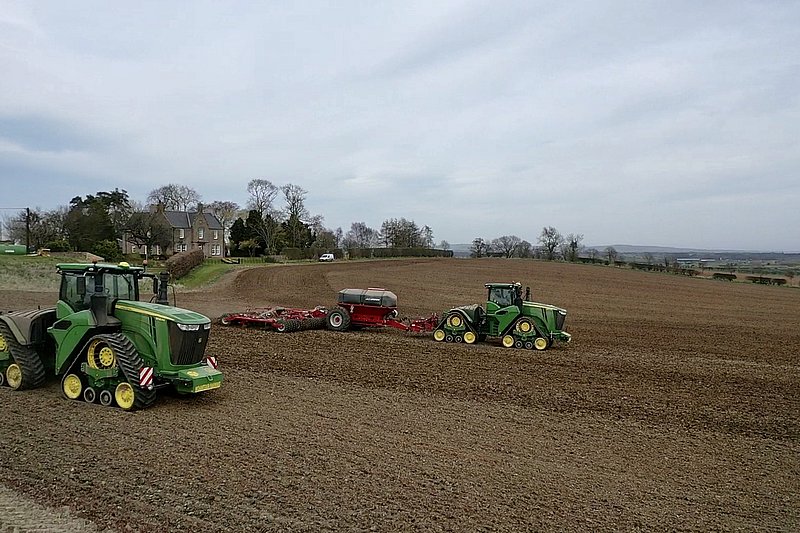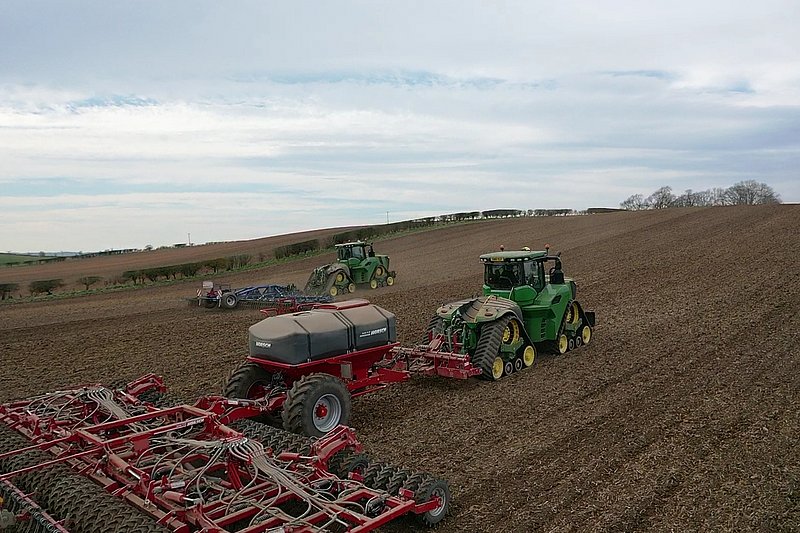Working with the Weather
By Simon Wyatt
While farming in Scotland has a slightly different set of challenges compared to farming elsewhere in the UK and Ireland, Jorin Grimsdale would not want to go to work anywhere else.

Mountfair Farming was started in 1987 when Jorin’s father, William, sold the family farm in Hampshire, England and bought the 280-hectare farm in the Scottish Borders. Located 8 miles west of Berwick-on-Tweed, Mountfair now contract farms 2200 hectares of land straddling the River Tweed that marks the border with England.
“It is a privilege to be able to farm in such a beautiful part of the country. Of course, farming has its challenges, but it is still an exciting and rewarding industry to be in. As farmers, our job is to be adaptable and flexible, to look at modern farming practices and apply what works best locally,” explains Jorin.
Jorin is Technical Director and his brother, Aidan, is Operations Director at Mountfair and they are both very much hands-on, assisted by two full time employees and further self-employed labour when required. In addition to the home farm, Mountfair Farming contract farms for five other landowners in the region. “We’re able to farm all 2200 hectares with just four-five people for the majority of the year. But with a tight weather window, we need to bring in more staff at harvest in order to get it all done in time.”

A short weather window is a recurring theme for farming in Scotland. However, Jorin is keen to highlight that weather conditions in the Scottish Borders are more comparable to farming in south-west England. “It’s wetter than East Anglia and south-east England, so we don’t get their droughts but drier than west Scotland.” Jorin adds that “although the Borders and Northumberland are now in a second year of very, very low April rainfall, questioning will this weather be more common? Like most farmers, we know each year is different.
“One of the key issues is the soil temperature cooling down quickly, so we need to ensure all our drilling is done by early October.”
In contrast to farming practices in southern England, where drilling may not begin until mid-October, once blackgrass germination falls away, Mountfair starts drilling 1100 hectares of wheat in early September and aims to complete it within two weeks.
“We are fortunate that we have no black-grass on farmed our area. It’s something that we are keeping a very close eye on, and we do have the opportunity to learn what management methods are working further south.” While delayed drilling is a common practice in areas with high levels of black-grass, an already short harvest window rules out this option.
“We are geared up to move quickly and efficiently at harvest. This paid off in 2019, as we already had 80% of the crop in the ground before the UK was hit by a very wet Autumn. It started raining on 21 September, with over 100mm falling at the end of September and early October. This limited days drilling after, although not as much as some areas further south, and it reminded us of the importance of September drilling.”
Using some spring cropping helps manage grass weeds and remaining flexible to alter the system to stop or take out any issues early has worked very well over the years.
The importance of developing good soil structure
When William Grimsdale moved to Berwickshire in 1987, he initially continued to plough and use a press drilling system but this became slow and expensive and he knew long term the importance of developing good soil structure was going to bey key and the detrimental effects of annual soil inversion. In 1998/99, he began to try reducing tillage before settling on a system which included a Horsch CO8 tine drill in 2002.
“We started with an 8m HORSCH tine drill before moving to a 12m HORSCH CO12 tine drill in 2006, which we ran for 12 years. It was a very good drill, very reliable and able to work well in a wide variety of conditions,” says Jorin.
By 2018, the Mountfair had fully developed its 12m controlled traffic farming system and a 12m Sprinter tine drill replaced the CO12. Complemented by a 12m Terrano FM tine cultivator, the farm also runs HORSCH Leeb PT280 self-propelled sprayer with a 36m boom and two tracked combines with 12m headers.

The goals have always been to maximise efficiency and enhance soil structure. This means improving yields and reducing costs, which has led Mountfair Farming to create a straightforward but very well managed rotation.
“We don’t apply a ‘one-size fits all’ approach across all the farms but we try to maintain an effective and profitable rotation. The cropping focuses on winter wheat with break crops, which delivers good returns and is sustainable in the long-term.” In addition to the 1100 ha of wheat, there are a further 450 ha of oil seed rape, 300 ha of spring oats, 250 ha of vining peas and field beans and around 100 ha of cover crops for environmental schemes.
Most of the soil in the area is medium clay loam with some parts becoming heavy clay. Jorin notes that there is significant levels of sand and silt too, which can be very abrasive on machinery. “My father was very passionate and knowledgeable on improving soil structure and this informs a lot of the farming practices we follow. There are a multitude of benefits to minimum tillage from improving soils and yield to reducing inputs costs and machine wear. We will try to shallow any cultivations when it is practical to do so.
“The Sprinter is a very versatile drill, and we use it for some direct drilling. It deals with trash brilliantly and we can also use it for some cultivation work too. It’s not a dedicated direct drill, such as the Avatar, but it does gives us the flexibility the old CO12 did for many years “
All wheat, oats, beans and peas are variable drilled with the Sprinter. Mountfair has been doing this for nearly 8 years, after having the soil scanned by SOYL, and the results have been very successful. Jorin explains that “variable seed rates have had a positive impact on yield and crop output, by getting more even plants established per square metre. Initially we didn’t vary it enough, but over the years we have fined tuned fields to get it right”
Jorin believes that they will increase the amount of direct drilling in the future, but the preference at the moment is to cultivate with a single pass. “We keep a 6m Simba SL for times when need to go a bit deeper and, indeed, we will plough if we have to. This only happens on less than 10% of the land and some fields haven’t seen a plough in 18 years.
“Where we have some brome creeping in, we will plough every eight to ten years and then return to minimum cultivation. We’ve found this buries the seed, which becomes dormant, and doesn’t cause a problem providing you then don’t disturb the soil too much. As the restrictions on the use of chemicals is only going to get greater, you need to take a flexible approach.”

Reducing soil disturbance is also the rationale behind having tracks on both combines and a tracked HORSCH Titan chaser bin. “Reducing compaction obviously helps the soil. We’ve found the chaser bin takes the pressure off the combines and allows them to operate far more effectively, particularly when they are not together.”
All happening at the same time
With 100ha of cover crops planted under the Scottish Agri-Environment Climate Scheme, Jorin sees this as an excellent way to improve the soil structure within a well-regarded system. “Due to the short window we have at harvest, there is no time to grow a cover crop after harvest – in fact, in August, it’s not unusual for us to be harvesting, cultivating and drilling all at the same time!”
Instead, cover crops are either grown from April to August or August to January. “They provide an opportunity to get some nutrients back into the soil, but we found the benefits are greater in some soils than others. We’re very flexible with our approach, carefully reviewing improvements in crop yields and input costs.
“Again, we’re not trying to apply the same technique everywhere. When you’re contract farming, you have a responsibility to maximise the profitability of the farm in a sustainable way, and we work closely with the landowners to do this.”
While wheat is the primary crop, oil seed rape is still very important. “In Scotland, slug damage is a big pressure when establishing winter-sown rape – they can annihilate a whole crop. We’re are also seeing some damage from flea beetle but this is much less of a problem than in some of the large arable farming areas around the country.”
The concentration of effort required at harvest is also significantly different to other parts of the UK. “We need far more drying capacity than would be required in the arable areas of southern England. Over the season, for wheat we usually average 18% to 19% moisture, but there are plenty of days where it will be 20-22%.”
Mountfair has just completed another improvement to its grain handling and drying with a further 3000 tonne store and large automated 50 tonne batch drier being installed. This system will work along side a biomass boiler and drying floors, and an old existing continuous flow drier, which will now support the newer systems.
As all harvested crops will need to be dried, this means more staff are required to ensure the driers are running at capacity. In addition, the increased workload of harvesting, cultivating and drilling – sometimes simultaneously – within a short time frame sees the seasonal workforce rise from 4 to 14.
“We’re lucky that we have a strong agricultural community in the area, and we can source staff from specialist agencies, or students from Edinburgh or Newcastle to support the mainline team.”
Mountfair has recently replaced its Leeb PT 280 self-propelled sprayer with the new PT 8.300 model
“Our sprayer is supported by a HORSCH Shuttle mixer tank system, which arrived in February. This was mounted and set up by Aidan and adapted to suit the Mountfair system, on one of two hydraulic demount chasses. The Shuttle has an 8000 litre tank, which matches the PT 8.300, and makes liquid fertiliser application and spraying logistics faster and simpler.”
Strong dealer support is also essential when time is precious. “Our local dealer, Keslo Harvesters, provides excellent support. They understand the pressures we are under and, combined with the support we get from HORSCH, it gives us greater confidence in the products. They are built around the same principles that match our farming approach.”